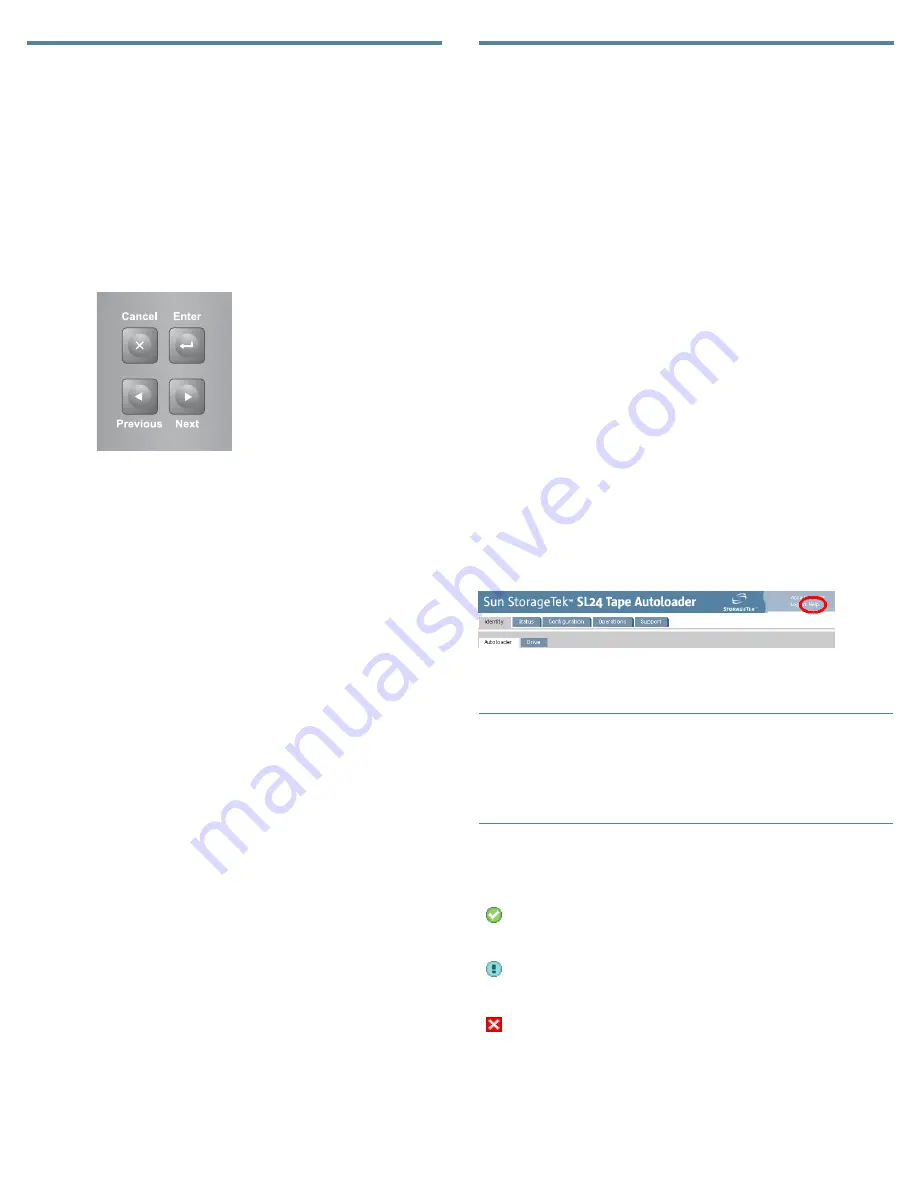
Using the operator control panel (OCP)
The OCP has a power button, four LEDs, four control keys, and
a 2
‐
line by 16
‐
character LCD screen. With the OCP, you can
monitor, configure, and operate most Autoloader functions from the
Autoloader front panel.
See Page 12 for the OCP menu tree.
Control keys
The OCP displays a menu that lets you access information and
execute commands using the four control keys.
10763
Cancel
— Cancels the current menu option, returns to the previous
menu level, or returns to the Home screen.
Enter
— Executes the current menu or selects the current option
displayed on the LCD screen.
Previous
— Selects the previous item or value in the currently
displayed menu.
Next
— Selects the next item or value in the currently displayed menu.
LED indicators
The OCP has four LEDs that provide a variety of information.
Ready
— Green when power is on, blinking with tape drive or
Autoloader robotics activity.
Clean
— Amber when a cleaning cartridge should be used.
Attention
— Amber if the Autoloader has detected a condition that
requires attention.
Error
— Amber if an unrecoverable tape drive or Autoloader error
occurs. A corresponding error message displays on the LCD screen.
Using the remote management
interface (RMI)
With the RMI, you can monitor, configure, and operate most
Autoloader functions from a web browser.
Sun recommends that, when possible, the RMI be used as the
primary Autoloader interface because the web interface provides
access to additional features, includes online help, and is easier to
use. However, the RMI is not required to use the product, except
to configure SNMP, IPv6, and logical libraries. The only tasks you
cannot do from the RMI are:
•
Opening the mailslot.
•
Initiating the Wellness test.
•
Saving and restoring files and downloading firmware via a USB
flash drive.
To enable the Autoloader’s RMI, follow the instructions in this
installation process to:
•
Connect the Autoloader to your local area network with an
Ethernet cable (Step 9).
•
Configure the network (Step 10).
•
Set the Administrator password using the OCP (Step 12).
Logging in
Using the OCP, find the Autoloader’s IP address from the
Info
> Network
screen. Open any HTML web browser and enter
the Autoloader’s IP address. Select the account type. For the
administrator account, you must also enter the administrator
password. Click
Sign In
.
Once signed in, click
Help
in the upper right
‐
hand corner for more
information about the fields and information in the RMI.
NOTE:
The Autoloader is shipped without an administrator password.
You must set the administrator password with the OCP before you
can use the RMI’s administrator functions. Once the administrator
password is set, you can access the RMI by providing the
administrator password on the login screen.
Status icons
The green
Status OK
icon indicates that the
Autoloader is fully operational and that no user
interaction is required.
The blue exclamation point
Status Warning
icon
indicates that user attention is necessary, but that the
device can still perform most operations.
The red X
Status Error
icon indicates that user
intervention is required and that the device is not
capable of performing some operations.
Page 3












